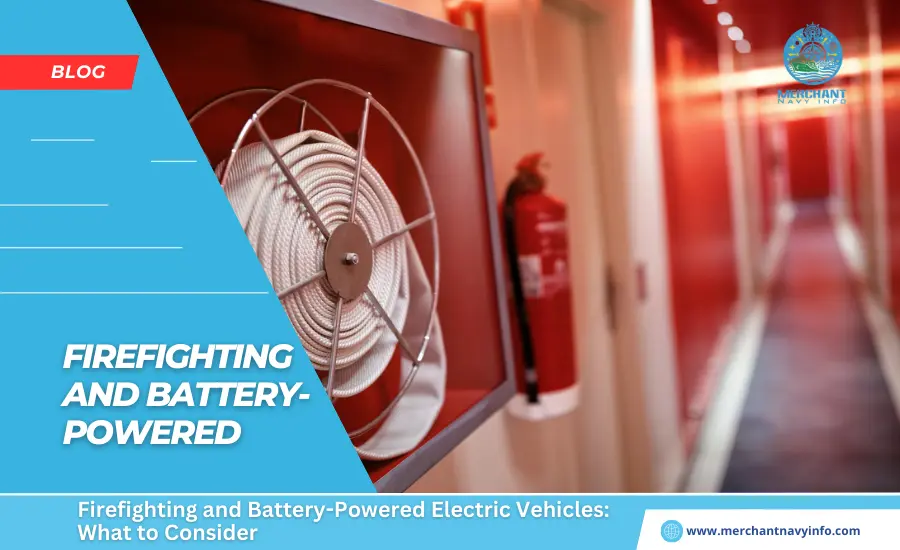
AMSA has published a Maritime Notice providing guidance to vessel operators. In developing response plans for firefighting operations using battery electric vehicles (BEVs). The issue of lithium-ion battery fires received widespread attention in 2023. Prompting the industry to take steps to address and contain this phenomenon. In light of the summer accident, decarbonization and electrification. Are increasing the number of maritime cargoes containing lithium-ion batteries from electric vehicles (EVs). And the risks that lithium-ion batteries pose to ships on board are attracting attention. A wide range of consumer and electronic products.
Recommendations
AMSA, therefore, recommends the following regarding firefighting and his BEV:
- In the event of a fire involving a BEV. The only way to cool the battery is with large amounts of water. Conventionally powered vehicles typically require 4,000 litres of water to fight a fire. It is estimated that a BEV fire consumes at least 10,000 litres. The Danish Fire Authority (DEMA) recommended using water at a flow rate of 400 litres per minute. And limiting the exposure time for people engaged in firefighting operations to 10 minutes.
- PCTCs typically do not have flood systems and rely on carbon dioxide (CO2) systems for vehicle deck fire suppression. It should be in notice that the risk of reignition is increasing significantly in a BEV vehicle fire. And that CO2 systems do not dissipate the heat generated by the fire or dissipate. The highly flammable gases released in a BEV fire.
- CO2 fire extinguishing systems have been successful in fighting fires on PCTCs when deployed quickly after detection and verification/confirmation of the fire. A research project is underway to assess and evaluate the effectiveness of CO2 fire extinguishing systems. The International Union of Marine Insurance (IUMI) recommends doubling the capacity of PCTC’s CO2 system. Operators should consult an accredited organization regarding the amount of CO2 intended to be used in the vehicle cabin for the transport of BEVs.
- Early detection, confirmation/verification, and rapid response times are critical to successful firefighting in PCTCs. Fixed fire extinguishing systems should first be used instead of manual extinguishing by crew members.
- In the case of the RORO-PAX ferry, expects early implementation of the flood system to limit the spread of the fire and allow for a controlled response. Crew members must be familiar with their correct use and the need to drain water from the vehicle deck effectively so as not to affect the stability of the vessel. To minimize the risk of explosion, it is imperative to vent highly flammable vapours from a Battery Electric Vehicle (BEV) fire in all confined spaces. The master of a Roll-On/Roll-Off Passenger (RORO-PAX) vessel must actively monitor the flow of steam emanating from a BEV fire. Their task is to skillfully maneuver the vessel to ensure that the steam passes away from critical passenger areas and emergency stations, including lifeboat launching and embarkation areas.
Flame Limitation
- Other ways to limit the spread of flame and heat include: B. Special fire blankets or other special fabric barriers for vehicles can be helpful until sufficient water is available. However, when using these blanket/special restrictions, you should first carefully consider the specific risks you may encounter. This includes limited access to vehicles on Ro-Ro decks and the rapid spread of BEV fires. Gas and smoke can reduce visibility and create extreme heat for personnel approaching the fire. These fire blankets are ideal as a preventative measure when vehicles work out to be at high risk of fire, such as B. Suppose it detects a battery coolant leak during a routine fire safety inspection. Thermal runaway continues while the vehicle’s fire blanket contains the flames.
- Because the smoke produced by a BEV fire is toxic, emergency teams responding to a fire must be equipped with firefighting clothing that complies with SOLAS II-2 regulation 10.10. BEV fires can lead to the generation of hydrogen fluoride, so decontamination procedures. And firefighting plans must also include it. This is a dangerous substance that can penetrate protective clothing. It is highly corrosive and toxic and can cause burns if it penetrates clothing and contacts skin. Vessel procedures for handling clothing and equipment exposed to BEV fire should take this risk into account.
- BEV crews must be equipped with additional equipment to ensure safety when fighting BEV fires, including:
- Defibrillators
- Gloves for use under high-voltage
- Gas detectors to analyze the atmosphere for explosive gases.
- A significant risk of reignition exists until the chemical chain reaction is complete. A well-equipped firefighting team must be able to monitor the fire scene and respond immediately until the removal of vehicle from the vessel.
- Ship operators should use additional safety equipment (e.g. respirators) to protect crew members from toxic fumes produced by BEV fires when performing emergency operations such as preparing to launch lifeboats. You should consider providing it to your crew. Ventilators are helpful to protect against toxic fumes produced by electric vehicle fires when performing emergency operations such as preparing to launch lifeboats.









